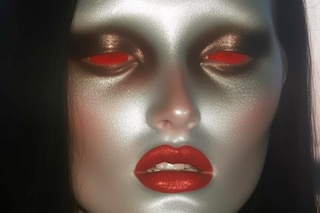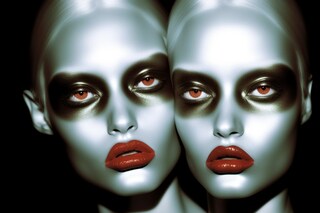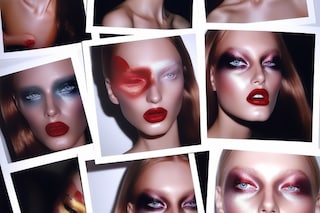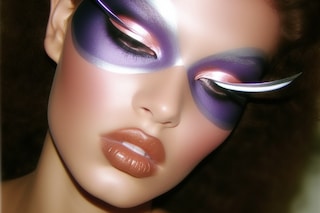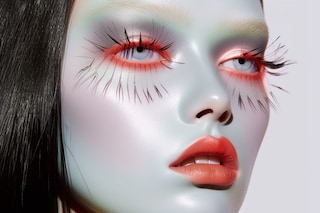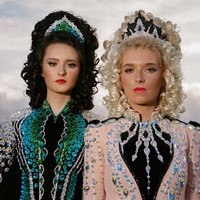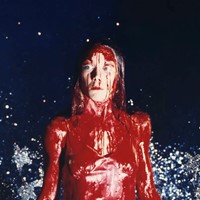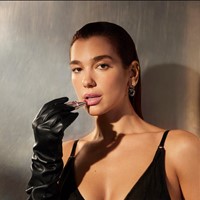On a new Midjourney-assisted beauty shoot, photographer Gil Anselmi and make-up artist Lisa Michalik open up the world of creative possibilities through AI and discuss whether they are worried about the future of the creative industries
How will the advancement of artificial intelligence impact the arts? That’s the question facing creatives right now. From ChatGPT threatening the livelihoods of writers to Grimes embracing Elf.Tech and urging fans to create songs using her AI-generated voice, AI is creeping into all aspects of the creative industry and dividing opinions on whether it will open up a new world of artistic possibility or be the end of creativity as we know it.
When it comes to imagery, platforms like Midjourney and DALL-E 2 are making new forms of creative expression possible and allowing us to imagine whole worlds that don’t exist – for better or worse. “Personally, I’d say the way I use AI enriches my creativity,” says photographer Gil Anselmi, who has been experimenting with Midjourney and similar software for about a year now. Always interested in new technologies, Anselmi says when she first started photographing it was the retouching process that interested her the most. Now she’s drawn to AI and its ability to project your “imagination” on a screen. “I’ve never really tried to retranscribe reality; on the contrary, my aim is to create a new one,” she says.
Wanting to delve deeper into the creative possibilities of AI, Anselmi teamed up with make-up artist and Dazed Beauty Community member Lisa Michalik on a new beauty shoot that ‘blends’ combinations of their respective works to create whole new images. The pair did not use any prompts or images that weren’t their own – the desire was to create something new rather than draw on and copy images that existed in the world already. And the results, they say, were surprising and inspiring.
Here, Anselmi and Michalik speak to Dazed about the shoot and their thoughts as creatives on the future impact that AI will have on the industry.
Where did the idea for this project come from? How did you start working together on it?
Gil Anselmi and Lisa Michalik: We wanted to do a project together, and we really wanted to create something with our own artistic direction. We started brainstorming several ideas for a shoot. At the same time, we were each using AI for different purposes. From there came the idea of doing something with my photos and her make-up. At first, it was almost a bit of a joke but then we realised that the result was really surprising and the process quite exciting.
Can you explain a bit about the process of creating images with AI and Midjourney? What are the steps?
Gil Anselmi: The process itself is quite simple: you upload images to the software. The aim is then to test the different possible combinations, and that’s what takes up a lot of time. It’s a hand-in-hand collaboration between Lisa, me and the software, so there are several approaches. You have to understand that we adapt to the software ourselves, it’s not magic.
Lisa Michalik: Creating images with Midjourney generally involves providing the platform with a starting image or series of images, then modifying the algorithm parameters to generate similar images but with variations. The exact steps depend on the project and the use.
Why did you choose not to use a prompt? And only modify the images rather than create something new?
Gil Anselmi: For me, it was a question of copyright. As a photographer, answering this question was essential. The models on which the various software programs are trained are via open-source databases. In general, they come from all sorts of public lists containing images and descriptions (it depends on the software because it seems to me that Midjourney feeds on images from Pinterest, for instance). What you need to understand is that the software won’t take a piece of an image and put that same image into another image. It will take ‘future’ images. In fact, to sum up, these images are simply predictions of probability. By not using a prompt, and by asking the software to use only our own images, we can be sure that it will only feed on our own images and not external ones.
Lisa Michalik: The decision not to use a prompt and to only modify existing images produced independently by Gil and I, rather than create something new is a creative decision that stems from the desire to mix our own work and not copy work that already exists.

Were you surprised by the images that were created from the process? What do you think of them?
Gil Anselmi: I find them surprising precisely and quite inspiring. We deliberately wanted to work on a beauty series, and there are some really beautiful ideas. Even before starting the project, we had an idea of the artistic direction we wanted to take, and I think we really succeeded in getting as close to that as possible, and that was the main thing.
Lisa Michalik: The results of AI can be surprising and offer interesting perspectives on art and creation. I was immediately seduced by the result and wanted to reproduce it in real life, although make-up is still my first love. That answers the next question, I think it’s an excellent tool that stimulates creativity. You can use the images in a crude way, but I think that afterwards you’ll want to draw on AI to create your own visuals.
Are you interested more in the idea and the process of creating with AI – or do you think the final images are interesting in themselves?
Gil Anselmi: Both! The process is appealing, but I’d still say that it’s the result that interests me most. Once again, I find the images very stunning, and there’s real work behind them.

What do you think of the impact that AI is having on art and other creative fields?
Gil Anselmi: Personally, I’d say that the way I use AI enriches my creativity. I have AI-specific ideas and projects. I really think it depends on how the software is used, and I totally understand why people are freaked out that certain jobs are disappearing. I think it’s quite difficult to project ourselves because, from a technological point of view, we’re only at the beginning. I can’t even imagine what will be possible with AI in a few years’ time. But on the other hand, maybe we’ll all get tired of AI pretty quickly and go back to something more artisanal? The world is cyclical... It was a digital panic and it changed a lot of things. It remains to be seen what AI will really change.
Lisa Michalik: The impact of AI on art and other creative fields is a subject of debate and discussion. Some consider that AI offers new creative possibilities, while others fear that it will lead to a standardisation of art and a loss of the human aspect of creation. Personally, I think you have to use it in the right proportions and know how to use it intelligently to sharpen your creativity.
Are you worried about AI taking over the arts? What do you think the future will look like?
Gil Anselmi: I think it’s all a question of how you use the software and being aware of what you’re doing with it. I don’t know what the future is going to look like, and I do think that AI can be quite dangerous, as in politics for example. But in the field of art, artists have been working with machines for a long time, so AI for me will be a tool like any other.
Lisa Michalik: AI will never take complete control of the arts. Instead, it is more likely that AI will become an increasingly used creative tool in many fields, including the arts. The future of AI in the arts will depend on how creators and art professionals choose to use it. But I think quite a few people have already had enough.

